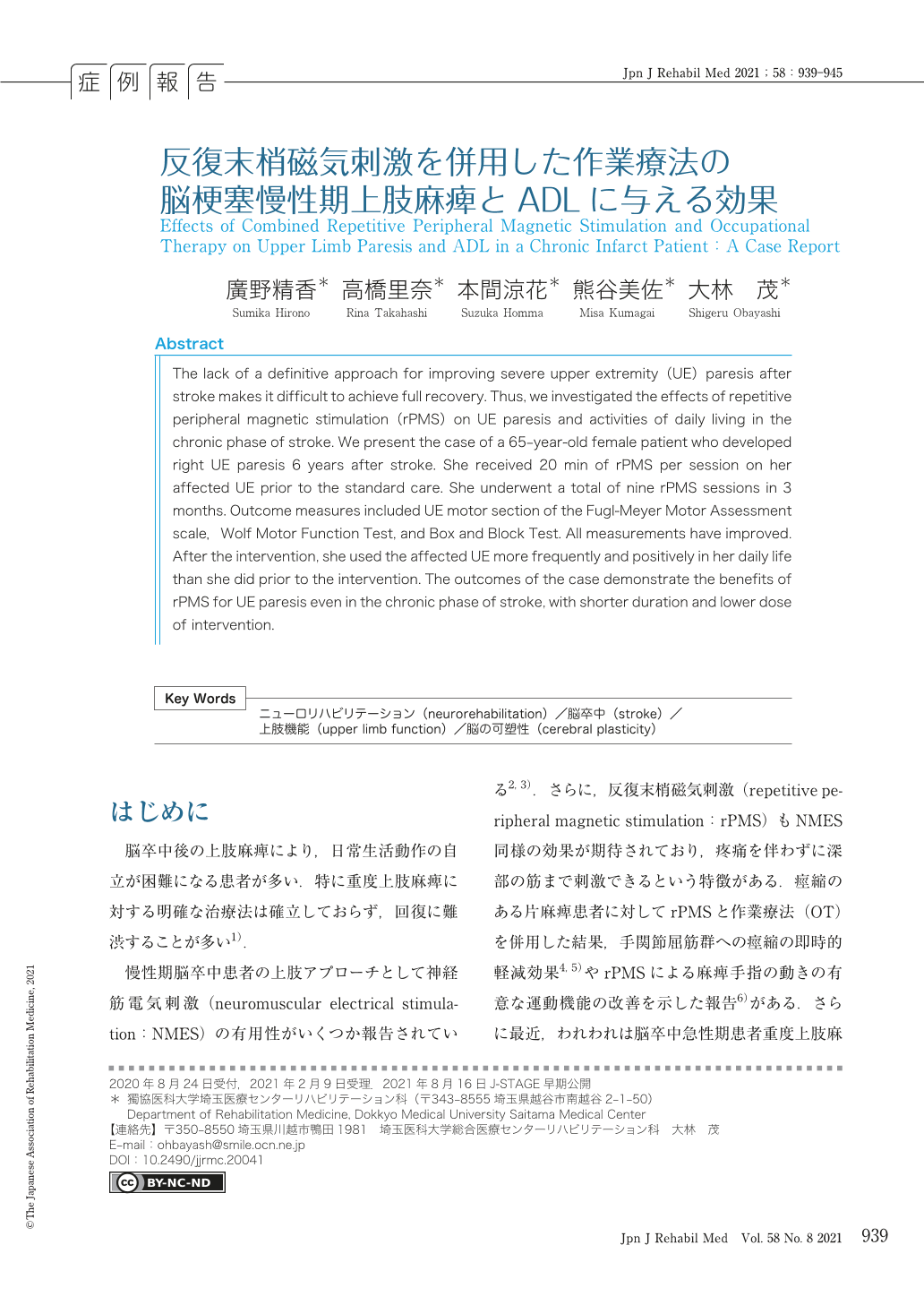Japanese
English
- 販売していません
- Abstract 文献概要
- 1ページ目 Look Inside
- 参考文献 Reference
はじめに
脳卒中後の上肢麻痺により,日常生活動作の自立が困難になる患者が多い.特に重度上肢麻痺に対する明確な治療法は確立しておらず,回復に難渋することが多い1).
慢性期脳卒中患者の上肢アプローチとして神経筋電気刺激(neuromuscular electrical stimulation:NMES)の有用性がいくつか報告されている2, 3).さらに,反復末梢磁気刺激(repetitive peripheral magnetic stimulation:rPMS)もNMES同様の効果が期待されており,疼痛を伴わずに深部の筋まで刺激できるという特徴がある.痙縮のある片麻痺患者に対してrPMSと作業療法(OT)を併用した結果,手関節屈筋群への痙縮の即時的軽減効果4, 5)やrPMSによる麻痺手指の動きの有意な運動機能の改善を示した報告6)がある.さらに最近,われわれは脳卒中急性期患者重度上肢麻痺に対しrPMSを併用したOTが上肢機能改善を促進する可能性を報告した7).rPMSを使用した報告は急性期の報告がほとんどで,慢性期脳卒中上肢麻痺患者にも有効であるかどうかは明らかになっていない.しかし,上記のようにNMESの慢性期での有効性が示唆されることやわれわれの急性期患者rPMS経験から,慢性期脳卒中患者でもrPMSの上肢麻痺への有効性が期待される.
本症例報告では,利き手交換により日常生活動作(activity of daily living:ADL)で非麻痺側上肢を使用していた慢性期右片麻痺患者が,麻痺側上肢にrPMSとOTを併用した訓練を外来通院で継続した結果,麻痺側上肢機能への効果を認め,麻痺側上肢の使用促進,ADLおよび手段的日常生活動作(instrumental activities of daily living:IADL)の拡大へとつながったと考えられたので報告する.
The lack of a definitive approach for improving severe upper extremity (UE) paresis after stroke makes it difficult to achieve full recovery. Thus, we investigated the effects of repetitive peripheral magnetic stimulation (rPMS) on UE paresis and activities of daily living in the chronic phase of stroke. We present the case of a 65-year-old female patient who developed right UE paresis 6 years after stroke. She received 20 min of rPMS per session on her affected UE prior to the standard care. She underwent a total of nine rPMS sessions in 3 months. Outcome measures included UE motor section of the Fugl-Meyer Motor Assessment scale, Wolf Motor Function Test, and Box and Block Test. All measurements have improved. After the intervention, she used the affected UE more frequently and positively in her daily life than she did prior to the intervention. The outcomes of the case demonstrate the benefits of rPMS for UE paresis even in the chronic phase of stroke, with shorter duration and lower dose of intervention.

Copyright © 2021, The Japanese Association of Rehabilitation Medicine. All rights reserved.


